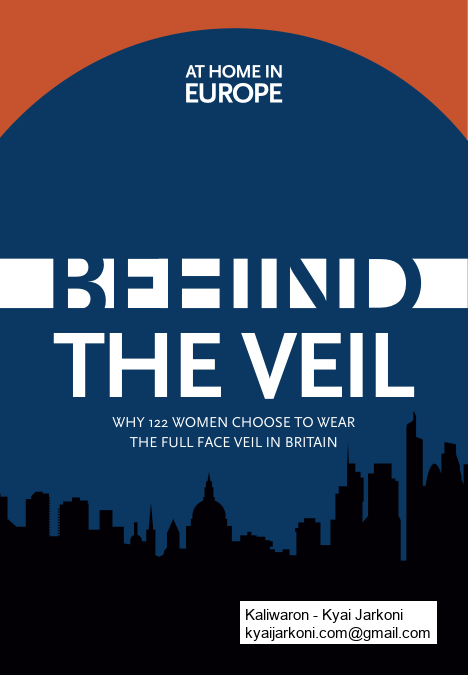Apr 1, 2015 — 5.3 Islamic knowledge on the niqab prior to wearing it. 65 6.1 Why are more women wearing the niqab? 73 gov.uk/datastorefiles/documents/2011-census-snapshot-religion.pdf (accessed July 2014) and Table.
122 pages
27 KB – 122 Pages
PAGE – 4 ============
Copyright © 2015 Open Society Foundations.This publication is available as a pdf on the Open Society Foundations website under a Creative Commons license that allows copying and distributing the publication, only in its entirety, as long as it is attributed to the Open Society Foundations and used for noncommercial educa- tional or public policy purposes. Photographs may not be used separately from the publication.ISBN: 978-1-940983-35-6Published byOPEN SOCIETY FOUNDATIONS 224 West 57th Street New York, NY 10019 United StatesFor more information contact:AT HOME IN EUROPE OPEN SOCIETY INITIATIVE FOR EUROPE 7th floor, Millbank Tower, 21–24 Millbank London, SW1P 4QP UKCover design by Dennis Ahlgrim l Ahlgrim Design GroupLayout by Judit Kovács l Createch Ltd. l Hungary
PAGE – 5 ============
3Contents Acknowledgements 7Foreword 9Glossary 111. Methodology 15 1.1 Sample profile 16 1.2 Class and ethnic mix of respondents’ neighbourhood 19 1.3 Citizenship 19 1.4 Ethnicity 20 1.5 Age 20 1.6 Employment 20 1.7 Educational qualifications 21 2. Key findings 23 2.1 Profile of the sample 23 2.2 Work and education 24 2.3 Routes to the niqab 25 2.4 Experience of abuse 29 3. Introduction: the full face veil in the British context 3 1
PAGE – 6 ============
4 CONTENTS4. Routes to the niqab: early influences 37 4.1 The niqab in the UK: an emerging trend? 37 4.2 Parents’ backgrounds and religious practice during respondents’ childhoods 39 4.3 Islamic schools 43 4.4 Family and friends 45 4.5 Conclusion 60 5. Routes to the niqab: Islamic references 63 5.1 Is the niqab compulsory? 63 5.2 Is it sinful not to wear the niqab? 65 5.3 Islamic knowledge on the niqab prior to wearing it 65 5.4 Acquiring Islamic knowledge 67 5.5 Islamic traditions 70 6. Routes to the niqab: wearing the niqab 73 6.1 Why are more women wearing the niqab? 73 6.2 Frequency of wearing the niqab 76 6.3 What does the niqab represent? 77 6.4 First day wearing the niqab 79 6.5 Respondents’ explanations 80 6.6 Two journeys to the niqab 83 7. Experience of abuse 87 7.1 Frequency and nature of abuse 87 7.2 The location of abuse 92 7.3 Profile of abusers 94 7.4 Media coverage 98 7.5 Responses to abuse 99 8. Conclusion 103Notes 105
PAGE – 8 ============
6 LIST OF TABL ES7. Experience of abuse Table 24. Type of abuse experienced 87 Table 25. Frequency of verbal abuse 88 Table 26. How many times have you been physically harassed? 90 Table 27. Have you been unfairly treated by a bus driver? 92 Table 28. Profile of the abuser, by gender and age 95 Table 29. Profile of the abuser 97 Table 30. Did you report physical assault to the police? 101
PAGE – 9 ============
7AcknowledgementsThis report has been prepared by the At Home in Europe project of the Open Society Initiative for Europe (OSIFE) in cooperation with a number of individuals who invested their time and effort into this publication. This report would not have been possible without the patience and generosity of the women who agreed to be interviewed by our researcher. We are extremely grateful to all of them. Their names in the report are pseudonyms in order to protect their privacy and safety. We are deeply grateful to Naima Bouteldja who was the researcher and writer of this report. Since 2012, she has worked with tireless dedication identifying and interviewing the women at the heart of this report and analysing and writing up their testimonies and experiences. Her continuous support and expertise has been invaluable. We would also like to warmly thank Robin Virgin from Pluto Press for his input and thorough re-reading of the report at its different stages. Naweeda Ahmad, Mayram Ramadan and Saliha Anwar did a great job transcribing the interviews and a big thank you to the three of them.The At Home in Europe project bears sole responsibility for the content of this report, including any errors or misrepresentations.
PAGE – 11 ============
9Foreword Behind the veil: why 122 women choose to wear the full face veil in Britain examines an issue causing considerable debate and controversy throughout Europe: the relationship between religion and European identity or, more succinctly, Islam’s compatibility with European values. The report offers the views of 122 women across the United Kingdom who wear the full-face veil, their reasons for doing so, and their experiences in public and private. It is an attempt to distinguish the real-life experiences and perspectives of the women who wear the veil from the popular myths and misperceptions promulgated by the media and national figures. This report follows an earlier study on France Unveiling the truth: why 32 Muslim women wear the full face veil in France (April 2011) which was based on the same premise in so far that it was an attempt to offer perspectives from the women who wear the garment and their reasons for doing so. A central belief of the Open Society Foundations is that all people in an open society count equally and should enjoy equal opportunities. The Foundations work to mitigate discrimination, in particular harm done to minorities through discriminatory treatment, and to ensure that access to equal opportunities for all is an integral part of government social inclusion policies. The At Home in Europe project, part of the Open Society Initiative for Europe, Open Society Foundations, focuses on research and advocacy activities that examine the position of marginalised groups in a changing Europe. Through its research, grant making and engagement with policymakers, civil society, and communities, the project explores issues involving the political, social, economic, and cultural participation of Mus- lims and other groups at the local, national, and European levels.
27 KB – 122 Pages
